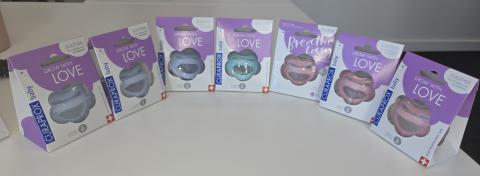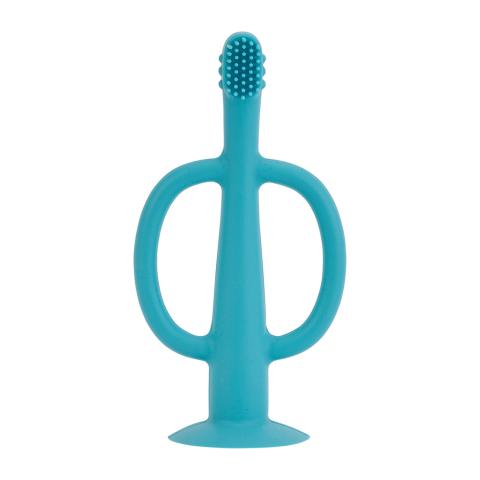On this page
Products the mandatory standard applies to
A baby’s dummy has a rubber or soft plastic teat, a hard plastic shield with holes and a ring or a handle to hold the device easily. Babies suck on dummies for comfort.
Dummies are also called pacifiers or soothers.
A dummy chain is a pin, ribbon, string, cord, chain or any similar article that attaches the baby’s dummy to their clothing.
This mandatory standard applies to:
- dummies for babies
- dummy chains and similar products to attach a baby’s dummy to their clothing.
Complying with the mandatory standard
The mandatory standard outlines the design, construction and labelling of babies dummies and dummy chains. It also outlines what’s not allowed for dummy or dummy chain decorations.
This mandatory standard references these voluntary standards:
- For babies dummies, suppliers have a choice of complying with certain sections of either the voluntary Australian standard or the voluntary European soothers for babies and young children standard.
- For dummy chains, suppliers must comply with certain sections of the voluntary European soother holder standard.
This information is an overview of how to comply with the mandatory standard. Suppliers must not rely on this information as a complete guide to compliance.
View the full detail of the mandatory standard.
Design and construction of babies dummy parts
All parts must be free from any sharp edges that could cause injury.
Shield integrity
The dummy shield must:
- not fit fully inside the baby’s mouth.
- have 2 or more ventilation holes of a specific size and in certain positions to allow the baby to breathe in case the dummy becomes lodged in the mouth.
Teat strength
The teat must be:
- smooth
- not allow fluid to leak inside or fill the teat as bacteria can grow and potentially cause infection.
Ring and handle
The ring or handle must be:
- secure and not detach or come apart from the shield. This can be a choking hazard
- designed to be gripped for easy removal of the dummy by an adult carer in case it becomes lodged in the baby’s mouth.
Testing
To make sure dummies comply with the mandatory standard:
- undertake tensile and shield tests make sure the dummy meets requirements for strength, durability and size
- when tested, no part of a dummy should become detached, torn, fractured or broken.
Suppliers must organise product testing through specialist testing laboratories.
Safety labelling
A warning notice must be provided with a dummy. The warning notice can come with the packaging or in a leaflet supplied with the dummy.
Packaging
Dummies must be sold:
- in a clean condition
- in a sealed pack
- including instructions for dummy use and hygienic care.
Decorations
Dummies must not have any:
- printing on the sucking side of the shield
- adhesive decals attached to any part of the dummy.
Decorations must not become detached during dummy conditioning or testing. These can result in a choking, inhalation or swallowing hazard.
Design and construction of dummy chains
Baby dummy chains must meet the requirements for length, impact resistance, durability and tensile strength.
- A dummy chain must have a maximum length of 220 mm so it doesn’t become a strangulation hazard.
- No part of the dummy chain should break, tear or separate when subjected to impact resistance and tensile strength tests so it doesn’t become a choking hazard.
- The garment fastener must not break, tear or separate during testing. Testing involves repeated opening and closing of the fastener jaws. The fastener jaws attach the dummy chain to the baby’s clothing.
- Adhesive decals and labels must not be attached to the dummy chain, as these can become a choking, inhalation or swallowing hazard.
Mandatory standard details
The Consumer Goods (Babies’ Dummies and Dummy Chains) Safety Standard 2017 sets out the mandatory requirements for babies’ dummies and dummy chains.
The accompanying Explanatory Statement has further information.
The mandatory standard requirements for babies’ dummies are based on certain sections of the:
- voluntary Australian standard AS 2432:2015 Standard for Babies’ Dummies
- voluntary European standard EN 1400:2013+A1:2014 - Child use and care article – Soothers for babies and young children – Safety requirements and test method.
The mandatory standard requirements for dummy chains are based on certain sections of the
- voluntary European standard EN 12586:2007+A1:2011 - Child use and care article – Soother holder – Safety requirements and test method.
You can buy the Australian standard at Standards Australia, Intertek Inform or Accuris.
You can buy the European standards at Intertek Inform or Accuris.
We can make a copy of these standards available for viewing at an ACCC office, subject to licensing conditions.
When a product does not comply
Fines and penalties may apply for failure to comply with a mandatory safety or information standard. For more information, see fines and penalties.
Suppliers may need to recall a product when it doesn't meet the mandatory standard or is potentially unsafe.
Related recalls
Related news
Business Services (CBS) will be enforcing a ban on ‘bling’ babies’ dummies and
chains.







